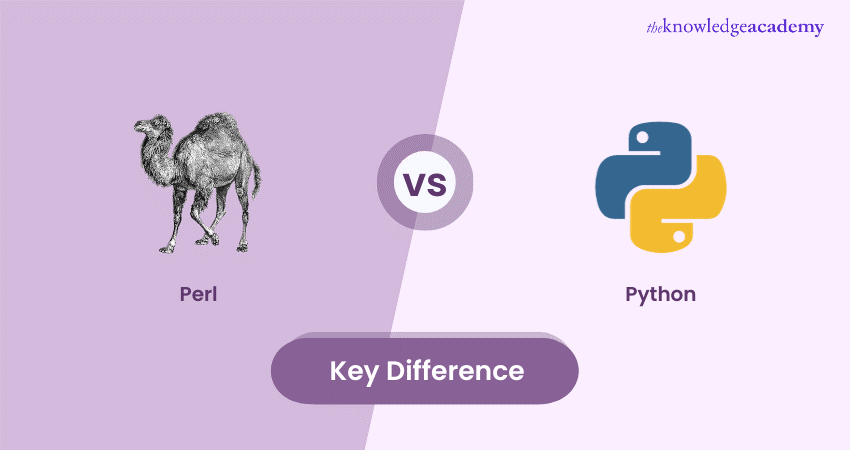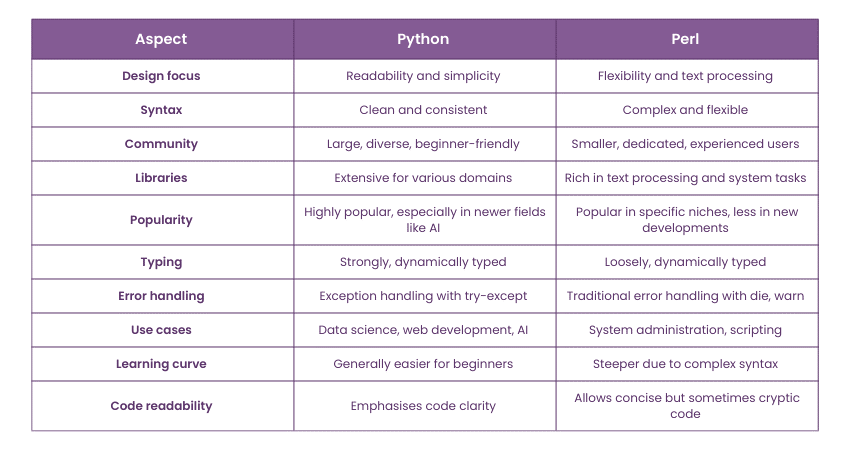We may not have the course you’re looking for. If you enquire or give us a call on 01344203999 and speak to our training experts, we may still be able to help with your training requirements.
Training Outcomes Within Your Budget!
We ensure quality, budget-alignment, and timely delivery by our expert instructors.

As a young developer, you might wonder about the difference between Python and Perl. Perl and Python are high-level, dynamic programming languages and have distinct characteristics and use cases. This blog will help you clear your confusion between Perl vs Python.
While Perl is often the go-to for system administration, scripting, and rapid prototyping, Python has gained immense popularity in web development, data science, and AI due to its straightforward syntax and robust standard libraries. Both open-source and multi-paradigm languages support procedural, object-oriented, and functional programming. Do you want to know how their nuances make them unique? This blog will help you understand the differences between Perl vs Python.
Table of Contents
1) What is Perl?
a) Features Of Perl
2) What Is Python?
a) Features of Python
3) Key differences: Python vs Perl
a) Syntax
b) Community
c) Libraries
d) Popularity
4) Conclusion
What is Perl?
Practical Extraction and Reporting Language (Perl) is a multi-paradigm language supporting procedural, object-oriented, and functional programming styles, offering programmers flexibility and expressiveness. Its comprehensive standard library, Comprehensive Perl Archive Network (CPAN), provides various modules for various tasks, further extending its capabilities. It is also known for its versatility and power in text processing and system administration.
Features of Perl
Perl, renowned for its flexibility and powerful features, offers a diverse range of capabilities:
a) Text processing: Perl excels in text manipulation, parsing, and regular expressions, making it ideal for extracting and transforming text data.
b) CPAN: An extensive collection of reusable scripts, modules, and libraries, CPAN is a treasure trove that significantly extends Perl's functionality.
c) Cross-platform compatibility: It runs on various platforms, including Windows, Linux, and MacOS, ensuring portability of scripts across different systems.
d) Multi-paradigm support: It supports procedural, object-oriented, and functional programming, allowing developers to choose the best paradigm for their project.
e) Dynamic typing: It is dynamically typed, allowing variable types to be determined at runtime, which adds to its flexibility and ease of use.
What Is Python?
Python, created by Guido van Rossum and first released in 1991, is a high-level, interpreted programming language renowned for its simplicity and readability. Emphasising code readability and syntax that allows programmers to express concepts in fewer lines of code, it supports multiple programming paradigms, including procedural, object-oriented, and functional programming.
Its comprehensive standard library and the vast ecosystem of third-party packages make Python versatile for various domains such as web development, data analysis, AI, scientific computing, and automation. Its clear syntax and community-driven development model have contributed to its widespread popularity and adoption across industries.
Features of Python
Python is celebrated for its many compelling features, which contribute to its wide-ranging applicability and popularity:
a) Readability and simplicity: Python's syntax is designed for clarity and readability. It is an ideal language for beginners and a favourite among experienced developers for its straightforward and clean code structure.
b) Extensive standard library: It has a rich standard library, offering various modules and functions for multiple tasks, from file I/O to web services, thus reducing the need for external dependencies.
c) Dynamic typing: It offers dynamic data type classification, allowing greater flexibility in coding and reducing the need for lengthy type declarations.
d) Cross-platform compatibility: Python code can run on multiple operating systems like Windows, macOS, and Linux without requiring any modifications, enhancing its portability.
e) Strong community support: A vast and active community contributes to a wealth of documentation, forums, tutorials, and third-party tools, making resources readily available for learners and professionals.
Become an expert in Python with our Python Course – register now!
Key differences: Python vs Perl
Let’s look at some of the significant differences between Python and Perl:

Syntax
Python is renowned for its clear, concise, and readable syntax. It is highly accessible to beginners and maintains readability for large-scale projects. The syntax enforces indentation, which makes the code visually clean and ensures that the code structure is explicitly defined. This clarity reduces the potential for errors and simplifies debugging and maintenance.
In contrast, Perl's syntax is often more eclectic and complex. Its flexibility can lead to harder-to-read and maintain code, especially for those unfamiliar with Perl's nuances. Its syntax allows for concise and expressive code, which can be highly efficient for experienced programmers. However, this efficiency can come at the cost of readability and simplicity. Perl scripts can quickly become intricate and opaque, especially when using advanced regular expressions and the various special variables Perl provides.
Community
Python boasts a vast and vibrant community. It's one of the most popular programming languages, partly due to its widespread use in growing fields like data science, machine learning, and web development. The Python community is known for being welcoming and supportive, offering extensive resources for beginners. This includes comprehensive documentation, many tutorials, active forums, and numerous conferences worldwide.
On the contrary, Perl's community, while smaller than Python, is exceptionally dedicated and has a rich history. Its community prides itself on the language's history in the Unix world and its continued relevance in fields like system administration, bioinformatics, and network programming. Perl Mongers, the worldwide Perl advocacy organisation, provides a network for programmers to discuss ideas and collaborate.
Libraries
Python's extensive standard library and its thriving ecosystem of third-party packages is one of its greatest strengths. The Python Package Index (PyPI) hosts many libraries and modules that extend Python’s capabilities to virtually every domain. Libraries like Pandas, NumPy, TensorFlow, and Keras have become industry standards in data analysis and machine learning. For web development, frameworks such as Django and Flask provide potent tools for building complex web applications.
On the contrary, Perl's library repository, CPAN, is one of the programming world's oldest and most mature collections of reusable code. It is an extensive archive of Perl modules covering various functionalities, from web development to system administration. Its libraries are known for their depth and powerful capabilities, particularly in text processing and system tasks.
Popularity
Python’s simplicity and readability have made it a preferred language for beginners and educators. Its versatility and many available libraries have also made it a favourite in professional environments, from startups to large corporations. It consistently ranks high on various indices that measure the popularity of programming languages, like the TIOBE Index and the GitHub Octoverse.
On the other hand, Perl was immensely popular in the late 1990s and early 2000s, particularly for web development and scripting tasks. While it has seen a decline in popularity with the rise of languages like Python, it maintains a strong presence in specific niches like system administration, bioinformatics, and network programming.
Do you want to learn more about Programming Languages? Register now for our Programming Training!
Conclusion
We hope that this blog has helped you understand the differences between Perl vs Python. Perl and Python are both powerful languages with unique strengths. Perl excels in text processing and offers flexible syntax, while Python stands out for its readability and extensive use in data science, AI, and web development. The choice between them depends on the specific needs and familiarity of the developer.
Make progress in your career with Perl – register now for our Basic Perl Programming Training!
Frequently Asked Questions

While Python and Perl share some common uses, such as scripting and text processing, Python has gained widespread popularity in fields like web development, data science, and artificial intelligence due to its readability and robust libraries. Perl, with its advanced text manipulation capabilities, remains a strong choice for system administration and legacy scripts. However, Python's versatility allows it to be effectively used in many areas traditionally dominated by Perl.

Generally, beginners find Python easier to learn due to its clear and straightforward syntax. Python's code readability and structure make it highly accessible to newcomers. Perl, with its more complex syntax and "There's more than one way to do it" philosophy, can be challenging for beginners. However, Perl's flexibility and powerful text-processing capabilities make it worth learning for specific applications.

While Python and Perl can sometimes be used interchangeably, particularly in scripting and automation tasks, they are not completely interchangeable. Python is often preferred for larger, more complex applications due to its readability and the wide availability of libraries, especially in fields like data analysis and machine learning. Perl, on the other hand, excels in quick scripting, text manipulation, and tasks where complex regular expressions are required. The choice between them usually depends on the specific requirements of the project and the programmer's familiarity with the language.

The Knowledge Academy takes global learning to new heights, offering over 30,000 online courses across 490+ locations in 220 countries. This expansive reach ensures accessibility and convenience for learners worldwide.
Alongside our diverse Online Course Catalogue, encompassing 17 major categories, we go the extra mile by providing a plethora of free educational Online Resources like News updates, Blogs, videos, webinars, and interview questions. By tailoring learning experiences further, professionals can maximise value with customisable course bundles of TKA.

The Knowledge Academy’s Knowledge Pass, a prepaid voucher, adds another layer of flexibility, allowing course bookings over a 12-month period. Join us on a journey where education knows no bounds.

The Knowledge Academy offers various Programming courses, including Basic Perl Programming Training, Visual Basic Course, and R Programming Course. These courses cater to different skill levels, providing comprehensive insights into Object-oriented programming language.
Our Programming Language blogs cover a range of topics related to PRINCE2, offering valuable resources, best practices, and industry insights. Whether you are a beginner or looking to advance your Project Management skills, The Knowledge Academy's diverse courses and informative blogs have you covered.
Upcoming Programming & DevOps Resources Batches & Dates
Date
 Basic Perl Programming Training
Basic Perl Programming Training
Thu 29th Aug 2024
Thu 28th Nov 2024







 Top Rated Course
Top Rated Course



 If you wish to make any changes to your course, please
If you wish to make any changes to your course, please


